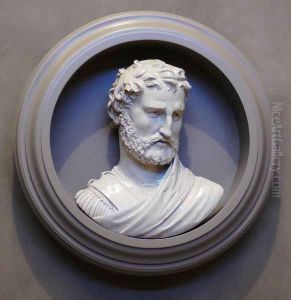Girolamo della Robbia Paintings
Girolamo della Robbia was a prominent Italian sculptor and ceramist of the Renaissance, known for his skillful work in glazed terracotta. Born into the famous Della Robbia family, a dynasty of artists renowned for their distinctive, brightly colored terracotta sculptures, Girolamo carried forward the family tradition with considerable acclaim. The Della Robbia family's artistic legacy began with Luca della Robbia, who was the uncle of Andrea della Robbia, Girolamo's father. This lineage ensured that Girolamo was immersed in an environment of creativity and mastery in art from a very young age.
Girolamo’s contributions to art are characterized by the exquisite detail and vibrant glazes that became synonymous with the Della Robbia workshop’s output. He was particularly adept at religious themes, creating altarpieces, Madonna figures, and other devotional objects that were highly sought after in Italy and beyond. His works are distinguished by their emotional depth and the vivid, lifelike quality of the figures he sculpted.
Despite the prominence of his family, specific details about Girolamo’s life and career are less well-documented compared to those of his forebears, partly due to the shifting artistic tastes of the 16th century which began to favor the grandeur of marble and bronze over terracotta. However, Girolamo managed to sustain the family's reputation through his innovative techniques and the high quality of his glazes, which have preserved the brilliance of his works through the centuries.
After the death of Andrea della Robbia in 1525, Girolamo played a crucial role in continuing the family workshop's operations, navigating the challenges posed by the changing artistic landscape of the Renaissance. His works continued to be in demand, testament to the enduring appeal of the della Robbia style. Girolamo della Robbia’s legacy is a testament to the enduring appeal of the Della Robbia family’s artistry, exemplifying the transition between the High Renaissance and the early Mannerist styles. His death in 1566 marked the end of an era for the Della Robbia workshop, although the influence of their unique art form lived on in European art for generations.
